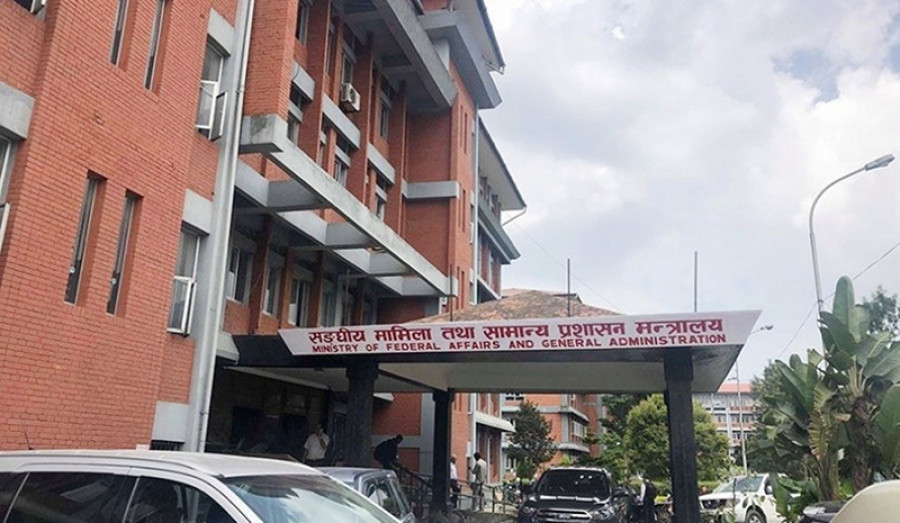National
Poorly performing local governments may see federal grant slashed
The Ministry of Federal Affairs and General Administration has introduced a working procedure to evaluate performance of local governments.
Prithvi Man Shrestha
Federal grants to the local governments could be reduced for performing poorly as the federal government is introducing rules and measures to evaluate fiduciary risks at the local level.
Amid reports of increased irregularities at the local level, the Ministry of Federal Affairs and General Administration came up with a ‘Working Procedure on Evaluation of Risk to Financial Discipline at Local Level’ aiming at evaluating governance of the local governments.
“The result of the evaluation will be considered as an indicator of how good the local governments are in financial governance,” the working procedure states. “The results of evaluation could be the basis for providing financial grants to the local governments concerned.”
As per the working procedure, District Coordination Committees will be responsible for conducting evaluation of the local governments. The status of governance will be evaluated based on 100 indicators which are related to governance related risks in the areas of process management, results and fiscal discipline.
“We have informally discussed with the National Natural Resources and Fiscal Commission about tying up the grant with results of the evaluation report,” said Gopi Krishna Khanal, joint secretary at the Ministry of Federal Affairs. “The commission will take the final decision in this regard.”
He added that the ministry has not made any concrete recommendation about how to increase or decrease the funding based on the evaluation of the performance in governance.
The federal government introduced the working procedure at a time when the Commission for the Investigation of Abuse of Authority has been receiving an increasing number of complaints about irregularities at the local level.
According to the anti-graft body’s annual report for 2019-20, complaints related to the Ministry of Federal Affairs, which is the contact ministry for local governments, were the highest (30.07 percent) followed by the Ministry of Education (16.36 percent) and the Ministry of Land Administration (8.29 percent).
Most complaints related to the Ministry of Federal Affairs are about local governments, according to the commission.
This is also evident from the fact that in 2013-14, when the elected local governments had not been formed, only 14.6 percent of the total complaints filed at the CIAA were related to the erstwhile Ministry of Local Development, which is now known as the Ministry of Federal Affairs and General Administration.
The anti-graft body’s data show that complaints about irregularities at the local level were highest in 2018/19 when 26.87 percent of the complaints were related to the Ministry of Federal Affairs. And in 2017/18, the ministry’s share in such complaints was 18.2 percent, according to the commission.
A survey report titled ‘Study on Corruption at the Local Level,’ unveiled by the anti-graft body in January last year, showed that more than 50 percent of the survey respondents said that corruption at the local level either remained as it was in the past or is thriving.
However, Khanal claimed that the working procedure was not designed with perceived issues of corruption at the local level. “In fact, the working procedure was introduced to identify the shortcomings at the local level and how the centre could help bridge the gap to ensure good governance,” said Khanal.
“Governance at the local level might have been affected not only due to irregularities or corruption but also due to the lack of human resources, expertise and other resources. Our intention is to unearth the issues and to correct undesired practices affecting good governance.”
He said that the indicators were determined based on the recommendation of the anti-corruption agency, Office of Auditor General and Financial Comptroller General Office.
The indicators related to process management have got the weight of 53 percent while indicators related to result will have weight of 13 percent and the indicators related to financial discipline will have weight of 34 percent.
The local governments scoring lower than 40 will be judged very poor in maintaining good governance, those scoring 41-80 percent will be categorised as medium level and those scoring over 81 percent will be judged good in ensuring good governance, according to the working procedure.
Some of the key indicators include: whether the local government presented budget on time and got it endorsed; whether the list of projects to be implemented were prepared after ensuring resources; and whether the development plan were prepared based on land use policy, transportation master plan, environment plan, local infrastructure development master plan and local economic and social development plans.
Likewise, the evaluators will observe whether the concerned local government has taken fiscal discipline measures such as collecting revenue and spending budget based on financial act and the budgetary provisions and whether fiscal equalisation grant has been used for meeting administrative expenditure.
Likewise, the evaluators will also see whether the budget allocated for capital expenditure has been transferred to recurrent expenditure.
They will also study whether a local government has been able to fund its administrative expenditure from its own resources, whether a meeting of the local executive body has been held at least once a month and whether public procurement law and rules have been properly followed.
Likewise, whether any local body has provided financial assistance to political parties and their sister organisations and whether there has been internal and external audit in time are other bases of evaluation.
Other issues to be overseen during the evaluation are whether a local government unit has spent over 80 percent of the capital budget, whether the local government has spent conditional grant on specified sectors and whether the consumer committees receiving any contract, have sub-contracted their work.
Whether elected representatives received perks and benefits based on the provincial law, whether elected representatives submitted the details of their property and that of the family members to relevant offices on time and whether a fully electronic bidding process has been implemented for awarding contracts will also be evaluated.
Khanal said the District Coordination Committees, whose role has been largely invisible under the federal set-up, would evaluate the performance of the local governments and would submit it to concerned local government, the provincial government and the federal affairs ministry in the centre.
“At a time when the District Coordination Committees are complaining that they have not been given any work responsibilities, it will be a huge responsibility for them,” said Khanal.
But the local government officials are of the view that even though the move taken by the federal government was good, the involvement of the federal government in preparing the working procedure was not a good idea.
“As per the constitution, the District Coordination Committee has the jurisdiction of evaluating the performance of the local governments,” said Ashok Byanju Shrestha, president of the Municipal Association of Nepal, a grouping of municipalities. “Instead of empowering them to prepare working procedures and monitoring the performance of the local governments, the federal government is getting involved in all these tasks does not send a good message with regard to the implementation of federalism in the country.”




 16.12°C Kathmandu
16.12°C Kathmandu















